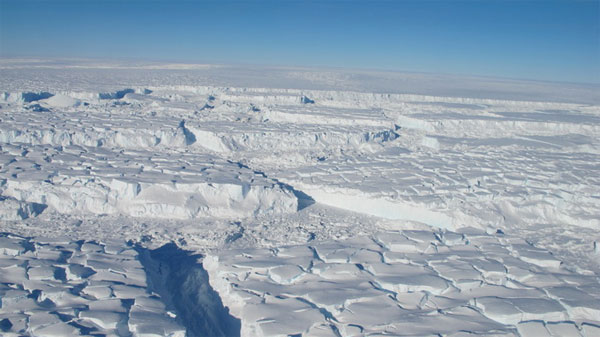Bacteria multiply 800m below the surface of Antarctic ice
Scientists discovered bacteria at a depth of 800m, below the Antarctic ice surface. This discovery raises hope, sees extraterrestrial life.
According to a study published in Nature, international scientists found that the microbial community proliferating at Lake Whillans lies at a depth of 800 meters below the surface of Antarctica ice. This is the first time scientists have discovered life in such an extreme environment.

Life can still exist under the icy Antarctic surface - (Photo: NASA)
The team said that these bacteria survive by obtaining energy from all kinds of chemicals in rocks and sediments at Lake Whillans."These bacteria are very active and have their own functions," said microbiologist Jill Mikucki of the University of Tennessee (USA).
She said they are part of a global biochemical system that scientists still don't understand.'About 10% of the earth's surface area is covered by ice. We know very little about biochemical activities in the environment below. Through internal chemical reactions, these bacteria do things like release nutrients from rocks, 'said Mikucki.
The team said the finding suggests that similar life could exist at Jupiter's moon Europa, Saturn's moon Enceladus and even Mars. Both Europa and Enceladus have oceans beneath the icy surface.
On Earth, experts are aiming for life research projects at Lake Vostok, a giant lake located beneath the Antarctic ice surface.
- Discover Antarctic secrets
- Detecting microbial populations in places without oxygen and light
- The mystery of the Solar System can be found in Antarctica?
- Super high resolution of the new map of the icy continent
- Highway legendary ancient city under 800m Antarctic ice?
- Life in Antarctica: bacteria also
- New material killed 99% of the bacteria
- The area of ice in Antarctica is mysteriously narrow
- Scientist decodes Antarctic ice holes
- Find the answer to Antarctic paradox
- Survive life on the surface of Mars
- The most toxic and strange forms of bacteria on the planet
 Why do potatoes have eyes?
Why do potatoes have eyes? 'Tragedy' the world's largest carnivorous life: Death becomes ... public toilet
'Tragedy' the world's largest carnivorous life: Death becomes ... public toilet Tomatoes were once considered 'poisonous' for 200 years
Tomatoes were once considered 'poisonous' for 200 years Detecting microscopic parasites on human face
Detecting microscopic parasites on human face Mud Volcano in Indonesia - A Devastating Natural Disaster from Both Natural Force and Human Greed
Mud Volcano in Indonesia - A Devastating Natural Disaster from Both Natural Force and Human Greed  Rare photos from the surface of Venus
Rare photos from the surface of Venus  First detection of traces of CO2 and H2O2 on the surface of the moon Charon
First detection of traces of CO2 and H2O2 on the surface of the moon Charon  Find out the reason for the nightly migration of trillions of zooplankton
Find out the reason for the nightly migration of trillions of zooplankton  Sensors quickly detect pesticides in fruit
Sensors quickly detect pesticides in fruit  The rover found the scary 'evil eye' on Mars
The rover found the scary 'evil eye' on Mars 